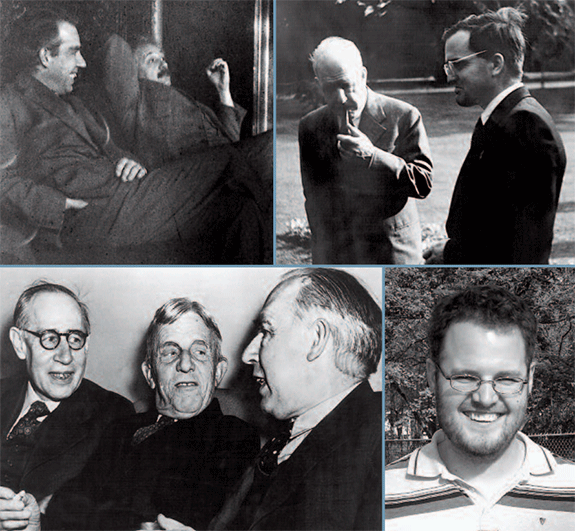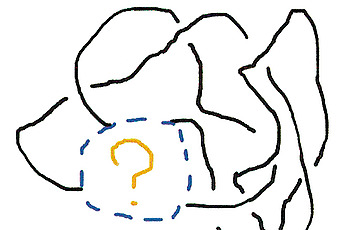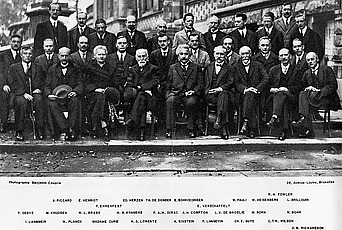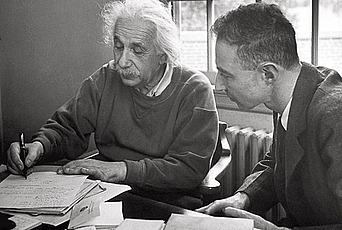“Scientific research in many domains of knowledge has time after time proved the necessity of abandoning or remoulding viewpoints which, due to their fruitfulness and apparently unrestricted applicability, were regarded as indispensable for rational explanation.” ––Niels Bohr
Since the advent of the theory of quantum mechanics, which governs motion and change in the subatomic realm, the question of how to deal with gravitational interaction on a quantum mechanical scale has been high on the scientific agenda. Although the understanding of gravitational interaction is still not complete, scientists are steadily learning more about its properties.
N. Emil J. Bjerrum-Bohr, a physicist and the fourth member of his family to be a Member at the Institute for Advanced Study, spent 2006–08 in the School of Natural Sciences studying the computation of amplitudes relevant to understanding physics and phenomenology in and beyond the Standard Model of physics as well as in quantum gravity.
“I have always had a great interest in understanding the necessary concepts for developing a theory for quantum gravity,” says Bjerrum-Bohr. “I believe that in order to fully understand the fundamental concepts of space, time, and matter, a theory for gravitational interaction valid at the quantum level will be unavoidable.”

The late School of Mathematics Professor Abraham Pais described the debates between Niels Bohr and Einstein as follows: “In a spirit of friendly and heroic antagonism, these two men argued about questions of principle.” From Bohr’s resistance to Einstein’s idea of the photon to their debate on the foundations of quantum mechanics, “the intellectual resistance and opposition of one against the most basic views held by the other continued unabated until the end of Einstein’s life,” wrote Pais. “At issue were the criteria by which one should judge the completeness of the description of the physical world.”
Yet theirs was a relationship marked by great respect and fondness. When Einstein was nearly seventy, he wrote, “That this insecure and contradictory foundation [of physics in the years from 1910 to 1920] was sufficient to enable a man of Bohr’s unique instinct and tact to discover the major laws of the spectral lines and of the electron shells of the atoms together with their significance for chemistry appeared to me like a miracle––and appears to me as a miracle even today. This is the highest form of musicality in the sphere of thought.” Of Einstein’s influence on Bohr, Pais wrote, “Just as in many sports a player goes through warming-up exercises before entering the arena, so Bohr would relive the struggles which it took before the content of quantum mechanics was understood and accepted. I can say that in Bohr’s mind this struggle started all over every single day. This, I am convinced, was Bohr’s inexhaustible source of identity. Einstein appeared forever as his leading spiritual partner—even after the latter’s death he would argue with him as if Einstein were still alive.”
Niels, who won the Nobel Prize in Physics in 1922 for his exploration of the inner structure of atoms, first visited the Institute as a Member in 1938–39. He wrote to Oswald Veblen, then Professor in the School of Mathematics, in advance of his stay, “It shall be so great a pleasure to me to come into a still closer contact with you and the other eminent mathematicians of your group and to try, as far as I can, to stimulate discussions on the fundamental problems in atomic physics among the younger scientists.”
Shortly before his arrival in Princeton, Niels learned that German scientists had succeeded in splitting uranium atoms. During his time at the Institute, he developed with John Wheeler, the late Professor Emeritus at Princeton University and a former Member of the Institute, a theory of nuclear fission that formed the basis for work in atomic energy. Wheeler recalled of their work together, “A work session might start with Bohr sitting or standing near the blackboard in my office. He would outline an idea based on his compound-nucleus model and sketch something on the board. Soon we would be trading a piece of chalk back and forth, drawing pictures and writing equations on the board.”
The Bohr family maintained a close connection with the Institute over the span of its first three Directors. Letters in the Institute Archives show that as early as 1933, Niels’s brother, the mathematician Harald Bohr, who was closely connected to the University of Göttingen, corresponded with founding Director Abraham Flexner in an effort to secure the safety and employment of German scholars, such as Richard Courant, and others threatened by the Nazi regime.
In 1943, Niels and his family fled from Nazi-occupied Denmark to Sweden in the cabin of a fishing boat. Soon Niels and his physicist son Aage Niels Bohr (b. 1922), who served as his assistant, became involved in the British and American war efforts, traveling to the United States and briefly visiting then Institute Director Frank Aydelotte, before traveling on to Los Alamos. Aage has recalled, “On our arrival in New York my father was requested to assume the pseudonym Nicholas Baker, while I became James Baker. We were issued with papers in these names, and at the beginning there was constantly an armed detective at our side. When we traveled around in the States, we were always accompanied by a bodyguard; over long distances the guard was changed, and the one who assumed responsibility for us had to sign a receipt for our delivery in good condition.”
Despite a standing invitation, Niels did not formally return to the Institute until after the war in 1948. Harald and Aage, who were also Members that year, accompanied him to the Institute. Like his father, Aage was awarded the Nobel Prize in Physics. He shared the Prize in 1975 with Ben R. Mottelson and James Rainwater for their work in determining the asymmetrical shapes of certain atomic nuclei. Harald was a distinguished mathematician whose main field of interest was analytic number theory. According to the late mathematician, historian, and former Member Otto Neugebauer, “The modern era of mathematics in England as well as in Denmark and Scandinavia will always be connected with the names of [G. H.] Hardy and [Harald] Bohr respectively.”
In letters in the Institute Archives, J. Robert Oppenheimer, Institute Director from 1947 to 1966, addressed Niels as “Uncle Nick,” a nickname referencing Niels’s wartime alias. “There is almost no end to the things I would wish to talk with you about, and I fear that if you come I shall be a burden with all my questions and stories,” Oppenheimer wrote to Niels in 1953. Niels returned to the Institute in 1954, when he gave a series of lectures at the Institute on the implications of modern physics for objective description in various domains of knowledge. He visited as a Member for the last time in 1958.
Growing up, Bjerrum-Bohr was well aware of the physics questions that fascinated his great-grandfather and Einstein. It was his great-uncle Aage who persuaded Bjerrum-Bohr to study physics rather than chemistry, the field of the noted Danish chemist Niels Janniksen Bjerrum, who was Bjerrum-Bohr’s paternal great-grandfather and a close friend of Niels Bohr. He is most well known for his work on the dissociation of strong electrolytes.
At the Institute, Bjerrum-Bohr worked on problems related to the incompatibility of Einstein’s theory of general relativity with basic quantum mechanical ideas. In particular, his research concerned the analytic structure of amplitudes, which provide a measure for the probability of particle interactions in quantum physical theories.
For many years, Feynman diagrams have been the standard tool for computing amplitudes. However, recent computations of quantum amplitudes for Yang-Mills theories and gravity by Edward Witten, Charles Simonyi Professor in the School of Natural Sciences, have inspired much more efficient ways of doing amplitude computations with high precision. Progress has come through combining input from string theory, extended supersymmetry, twistor variables, and the clever use of unitarity methods. Consequently, many amplitudes in Yang-Mills theories that are relevant for quantum chromodynamics and were previously considered unattainable are now readily available. Such results are important for the comparison of theoretical and experimental data in scattering experiments, like those being conducted at the Large Hadron Collider in Switzerland. “This research has the potential to revolutionize the way we think about physical theories such as particle physics and string theory,” says Bjerrum-Bohr. “It might lead to new insights in how to formulate a fundamental theory of quantum gravity.”
In addition to relishing the freedom to explore many ideas important to his research and becoming acquainted with scientists from all over the world, Bjerrum-Bohr felt a strong connection to the Institute’s natural surroundings. “There is nothing that compares to walking in the Institute Woods or sitting on the benches next to the Institute Pond,” says Bjerrum-Bohr. “The walking trails through the sunlit forest of the woods bring me back to summer vacations in the Tisvilde forests of northern Zealand where my great-grandfather’s beloved summer cottage is located. I believe that when visiting Einstein at the Institute my great-grandfather must have felt very at home walking through the Institute Woods, pondering questions in the field of physics, smoking his pipe.” ■



